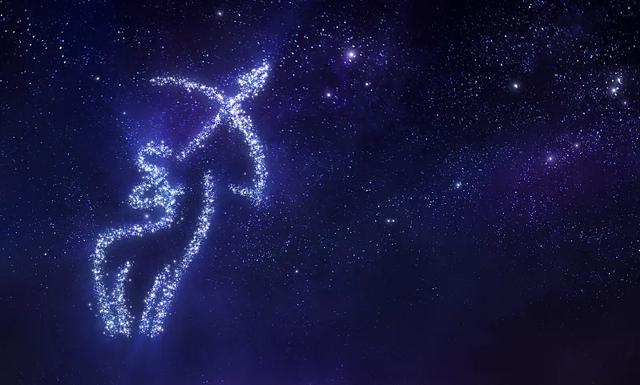
“火样的生灵:人马座”,新晋诺奖诗人露易丝·格丽克这样描述母亲在她梦中的样子。“她的箭矢不见了,她的翅膀蜕变成双臂——人在城郊的公园里。”意象的对比之中泛出一些落寞。
如果在出生前可以挑选,为什么不尝试一下人马座/射手座呢?(后文统称“人马座”)搜索引擎上弹出的形容词赋予了这个星座精彩的人设:诚实、冒险、乐观、独立以及善于思考。
古希腊神话中的“半人马凯隆”算是“初代”人马座代言人。据说他用哲学和智慧驯服了自己野性的一面,作为神箭手训练出了阿喀琉斯这样的英雄。他牺牲了自己,换了“盗火者”普罗米修斯一命。以这样一位神祇为蓝本的星座似乎无可挑剔。
“如果你热爱这个世界,你会听到苍穹的音符:仰望。”
节选自《苍穹的歌》,格丽克
凯隆和星座的世界,是人类给自己打造的思维拐杖,苏美尔人、巴比伦人和古希腊人等等藉此在探索星空与大地如何互动的道路上步履蹒跚。面对从漫天星河中浓缩出的十来种人生观,越来越多的后来者开始疑惑,奥林匹斯山上的智慧到底有多靠谱?星相、占星和天文学在这种怀疑中渐渐分道扬镳。
“事后察觉,
不是意象的失准,
而是关联的谬误。”
节选自《望远镜》,格丽克
从古巴比伦开始,占星术和天文学的关系就有些若即若离。二者都从观测天象出发 ,但有着不同的目的:天文学侧重预测天体的移动,而占星术倾向于解释这些移动的含义。观测本身的技术局限让释意成了空中楼阁。湮没了无数谬误之后,历史和星瀚两条彼此相望的长河终于渐渐交汇,艾萨克·牛顿站在了潮头。万有引力的发现让他成了新“神”,站在一座远高于奥利匹斯的“山峰”之上。随着天文学日益严谨,占星术开始在娱乐版面开辟新的阵地。
……晨曦遴选着它的目标
拥抱什么,遗弃其他
划定光与影的界限,笃定地,却看似漫不经心
回旋,揭示每一个抚摸到的细节
一丝不苟……
节选自《破晓》,格丽克
科学发现的行进方式,仿佛阳光点亮诗人昏暗的房间。光可以启发诗人,也可以启发科学家,但对后者来说,等待往往更加漫长。
假设光速不变,爱因斯坦开始重新审视牛顿两个世纪前总结的理论,狭义相对论应运而生。又经历了十年的冥思苦想,这位二十世纪的物理学巨人才终于让相对论与引力达成和解。当一种硕大无朋、连光线都能够“吸引”的宇宙存在浮现于他的方程另一端时,爱因斯坦犹豫了。什么东西,足以“洞穿”广袤的太空?
等待了几千年,“凯隆”对人类露出了肯定的微笑。1971年,在广义相对论提出后半个多世纪,人类从人马座探测到了无线电波源,暗示了黑洞存在的可能。又过了近半个世纪,德国人赖因哈德·根策尔和美国人安德烈娅·盖兹从观测的角度印证了人马座黑洞的存在——一个质量甩下太阳好几百万条街、具有极强吸引力的庞然大物。
与来自英国的黑洞研究者罗杰·彭罗斯一起,三位科学家分享了2020年诺贝尔物理学奖。
从星相、占星到发现黑洞,人类宇宙观的修正历经了漫长的岁月。幸好,耐心仍是我们最看重的品质之一,尤其是在紧迫感无孔不入的时代。
对于全世界的人马座们来说,这可能不是个好消息。星座分析似乎对“火象星座”的耐心不太有信心。本篇专栏的作者——一个骄傲的人马座编辑——对此不太赞同:
“凯隆”已经在星空中耐心地等了我们几千年,不是吗?
注:本篇选摘诗句来自2020年诺贝尔文学奖得主露易丝·格丽克的诗集《诗1962 – 2012》(英文版,原文见下)、诗句中文为编辑试译。
Sidelines | Celestial Music from Sagittarius
Sidelines is a Column from CGTN's Social Media Desk
My mother was unharmed — her arrows disappeared, her wings
turned to arms. Fire creature: Sagittarius. She finds herself in —
a suburban garden.
Fugue, from Averno, by Louise Glück, 2020 Nobel Literature Laureate
Who wouldn’t love to be a Sagittarius, one of the “Fire Trigon,” upon reading the sign’s inbuilt qualities: honest, adventurous, optimistic, independent as well as philosophical?
The traits lent to Sagittarius originally characterize Chiron, the Greek mythological figure, half human and half horse, who is associated with the zodiac sign. Tales have it that Chiron was an excellent archer, and Achilles his proudest apprentice. The master sacrificed his life for the exoneration of Prometheus who was punished to death for leaving fire to the mortals.
…she’s telling me that when you love the world you hear celestial music: look up.
Celestial Music by Louise Glück
We mortals on Earth never cease our effort to make sense of the eternal laws with which the heavenly bodies move, first with the belief in divinity that produces Sagittarius (Zeus groups stars in the shape of Chiron to remember him), among other astrological creations that were believed to bear on earthly life. But the urge to establish our relations to all different natural phenomena beyond the simple dual of the mortal and immortal drives us further down a different path, on which the division of astrology and astronomy is a milestone.
You realized afterward
Not that the image is false
But the relation is false.
Telescope by Louise Glück
The two terms were never fully interchangeable even in the Babylonian days when what we now know as astrology began to take shape. That both were founded in the observation of the images of the sky might blur the boundary between them. But their purposes differed. Astronomy was about predicting the stellar movements, astrology about interpreting them, i.e. seeking relations between the Earth and heaven where there is none, an error begotten by human knowledge’s limit. Centuries had passed since the Babylonians started searching for revelations from constellations, during which astrology and astronomy sometimes mixed with each other in the public discourse, until Sir Isaac Newton’s work further separated the two: gravity, rather than Zeus, arranges the stars. With that discovery astronomy has ascended more quickly into the scientific hierarchy as an inquiry into the laws of the universe, while astrology moves up and down the ladder of popular distraction.
…the sunlight specifying
these but not other objects,
setting boundaries, sure of itself, not
arbitrary,
then lingering, describing each thing in detail,
fastidious…
Dawn by Louise Glück
The accumulation of scientific discoveries leading up to the eureka moment often takes place in a similar fashion to the sun lighting up the poet’s room.
By rethinking Newton’s laws of motion, Albert Einstein published his Theory of Special Relativity in 1905. By revising his own design, the Nobel Prize winner had taken another painful 10 years to reconcile the Special Relativity with gravity, arriving at the Theory of General Relativity.
Yet the analytical power of Einstein’s beautiful formula stunted the physicist giant himself. At the end of his equation lies a space monster that devours everything including light. Einstein hesitated, imagining that the universe must have a way to heal up before parts of it get hollowed out.
More than half a century later, Sagittarius helped where Einstein felt uncertain. In 1971, scientists detected a faint source of radio noise called Sagittarius A* (located in the constellation) at the center of our Milky Way galaxy, 26,000 light-years from Earth – “celestial music," isn’t it? When Dr. Reinhard Genzel and Dr. Andrea Ghez concluded that the source was a supermassive black hole, confirming Einstein’s theorization, almost another 50 years had passed.
For their findings, Dr. Genzel and Dr. Ghez have won the 2020 Nobel Prize in Physics together with Dr. Roger Penrose, who also contributed to proving that Einstein’s equation is right about black holes.
Revising our worldviews takes time, as evidenced not only by how long it has taken to locate a black hole but also by how many people may still believe in astrology as scientific (a 2017 Pew Research survey found 30 percent of Americans were under its spell). Patience is required for advancing our knowledge, be it about literature, physics, astronomy or the new coronavirus.
This may sound a little disappointing to “Sagittarians” across the world. According to their astrological portfolio, patience isn’t a strong suit for people born under the sign.
Your columnist, who is also a Sagittarius, shall beg to differ on that point by citing Louise Glück’s work once again: look up. Listen to the “celestial music” that helps us trace the black hole. The “Sagittarius” in the sky – the original one – waited for us to reach it for thousands of years.
Quite patient, don’t you think?
Note: All the poetry quotes above are extracts from Poems 1962-2012 by 2020 Nobel Laureate in Literature Louise Glück, published by Farrar, Straus and Giroux. The profundity of these lines, when put back to the respective works from which they are borrowed, far exceeds what’s intended within the boundary of this article.
,





